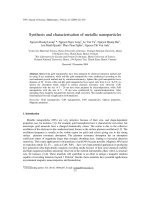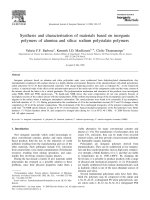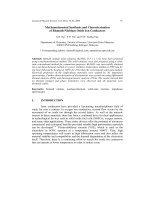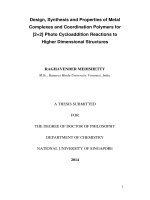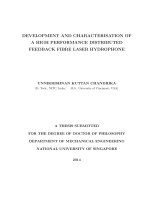Synthesis and characterisation of electrical conducting polymers co polymers based on omega functionalised 3 alkylthiophenes 5
Bạn đang xem bản rút gọn của tài liệu. Xem và tải ngay bản đầy đủ của tài liệu tại đây (76.71 KB, 15 trang )
Chapter 5
Conclusion and Suggestion for Future Work
182
1.
Summary of the project
As mentioned in Chapter 1, the aim of this project is to develop graft copolymers
of polythiophene/poly(3-alkylthiophene) with commodity polymers like
polystyrene and PMMA through an alkyl chain linkage in order to form materials
with good conductivity and processability. The following work was carried out to
achieve this goal:
1). A series of
functionalised alkylthiophene monomers, 3-( -
bromoalkyl)thiophenes, were synth
esised based on a reported method.
These monomers were polymerised using oxidative polymerisation method to
give a series of novel
polymer
s, poly[3-( -bromoalkyl)thiophenes]. Both the
monomers and polymers were fully characterised. Attempts to further
functionalise these polymers at the
position by replacing the bromo moiety
through Gringnard reaction have proven to be difficult. Although it is possible to
replace the
moiety by other reactions, this approach was not pursued further.
2). In the second attempt to form a graft copolymer of polythiophene and
commodity polystyrene, a
novel
functionalised 3
-alkylthiophene monomers
and
3-{ -
[1
-(p-
vinylphenyl)]hexyl}thiophene
were synthesised.
S
(
C
H
2
)
n
B
r
[
]
m
n = 4 pTHC
4
Br
6 pTHC
6
Br
8 pTHC
8
Br
10 pTHC
10
Br
12 pTHC
12
Br
183
Based on this monomer, a series of graft copolymers of
poly
styrene
and
polythiophene can then be realised. It was found that the most conductive
copolymer in this series is a system in which this monomer is copolymerised with
alkylthiophene and styrene. The experimental data seem
ed
to support the idea that
cro
ss linkages in the copolymer system affect the properties of the copolymers
.
The commodity polymer backbone also play
ed
an important role in determining
the
graft copolymer
s’
conductivity. These points will be further discussed in the
next section.
3).
Th
e graft copolymers of polythiophene and commodity PMMA were
synthesised based on a novel compound,
11
-t
hiophen
-3-
yl
-
undec
-1-
en
-3-
one.
This compound was formed through a new process starting from 3-
(unde
-
10
-
enyl)thiophene. All intermediate products were
characteri
s
ed.
A novel side
product,
11
-
thiophen
-3-
yl
-
undec
-3-
en
-2-one, was also identified. Amongst the
graft copolymers formed, it was found that the most conductive polymer was a
S
CH
2
8
O
5
S
C
6
H
12
Ph
3
184
system that incorporated the monomer, alkylthiophene and MMA. The
conduct
ivity and processibility of polythiophene and PMMA graft copolymers
w
ere
also found to be improved compared to polystyrene and polythiophene graft
copolymer. The most conducting graft copolymer achieved
a
conductivity of 3.3
S/cm.
In conclusion, graft copolymers of polythiophene and two commodity polymers
,
polystyrene and PMMA were formed. Through tr
ia
l and error the most
conducting systems were identified. Some of the graft copolymer systems
p
oss
ess
good processibility as well as conductivity and has the potential to be used as anti
static material
etc.
185
2.
Comparison between the two series of copolymers
based on PS and PMMA
The two main monomers used to synthesise the two series of copolymers were 3-
{ -
[1
-
(p
-vinylphenyl)]hexyl}thiophene and 11-t
hiophen
-3-yl-
undec
-1-
en
-3-
one.
These two monomers can undergo chemical polymerisation themselves
using
AIBN as initiator followed by oxidative polymerisation using FeCl
3
.
However, by
doing so, two graft copolymers that have poor conductivity and solubility were
affor
ded
. This could be attributed to possible cross-linking in the structure of the
copolymers. The idea is illustrated as follow
s:
In the first step
,
the commodity polymer
backbone was formed
:
Ideally, in the second oxidative polymerisation step
, the f
ollowing will form:
Based on the experimental data, it was more likely that the following actually
occurred:
A
TH
AIBN
A
TH
A
TH
A
TH
n
A
TH
A
TH
A
TH
n
m
A
T
H
AIBN
A
TH
A
TH
A
TH
n
186
Fig. 5.1
Illustration of possible structures of copolymer formed from 100%
monomers
.
A: commodity polymer backbone TH: thiophene/3
-alkylthiop
hene
After the first polymerisation process, the thiophene group would be ‘dangling’ on
the commodity polymer backbone to form a ‘comb’ shaped structure. If these
thiophene groups did not join the neighbouring thiophene groups but rather, connect
with the thiophene groups on other commodity polymer backbones during the
following oxidation state, a three-dimensional network would result. In which case, a
double
- layered copolymer structure with extended conjugation length would be
unlikely to form.
This
woul
d
result in low conductivity and insolubility. The
possible
reason for the occurrence of this cross linkages could be due to the steric effect
exerted from the polymer backbone or simply, random association.
A
TH
A
TH
A
TH
n
+
A
TH
A
TH
A
TH
n
A
TH
A
TH
A
TH
n
A
TH
A
TH
A
TH
n
A
TH
A
TH
A
TH
n
A
T
H
A
TH
A
T
H
n
A
TH
A
TH
A
TH
n
A
TH
A
TH
A
TH
n
A
T
H
A
TH
A
T
H
n
187
Reducing the concentration of the thiophene groups by copolymerising the monomer
(3
-{ -
[1
-(p-vinylphenyl)]hexyl}thiophene) with PS initially followed by FeCl
3
oxidation did not improve the properties of the copolymers either. The properties of
the copolymers only improved after large amounts of ‘spacer’ units, 3-
alkylthiophenes, were introduced into the system. The presence of these units during
the second polymerisation process would have prevented the thiophene groups on the
precursor copolymers from conjoining, thus reducing the chances of the formation of
a ‘closed’ network. In doing so, a polythiophene backbone with extended conjugation
can be formed which explains the improved conductivity.
A comparison between the PS
co
poly(3-alkylthiophen) and PMMA
co
poly(3-
alkylthiophen
e) shows that the PMMA copolymers possess
relatively
better
properties. The PS copolymer containing 3-octylthiophene groups is not very soluble
and can only achieve a conductivity of ~0.2 S/cm.
Their
PMMA counterparts, both
copolymers containing 3-butylthiophen and 3-
dodecylthi
ophene, are much more
soluble and have conductivities one order higher. Since the difference between these
two groups of copolymers
is
the commodity polymer
used
,
t
he results suggest that the
phenyl rings in the PS backbone may adversely affect the planarity of the
polythiophene backbone and thus disrupt its conjugation which would have resulted
in lowered conductivity
.
When thiophene, instead of 3-alkylthiophene, was used as ‘spacer’ units, PMMA
copolymer
s exhibit better conductivity and solubility as co
mpared
to its PS
188
counterpart. XRD of the two copolymers suggests that the PMMA copolymer has
a
higher
level of
crystallinity. This demonstrated that the morphology of the conducting
backbone still plays an important role in determining the conductivity of these types
of copolymers.
In summary, comparisons between the two series of copolymers demonstrated the
importance of polymer backbone structure, which exerts a direct influence to the
resultant polymer properties. The conductivity of
such
graft copolymer was found to
not only depend on the
conductive
polymer backbone but also on the commodity
polymer backbone structure as well.
This
information
could be useful when altering
and
improving the
electrical
properties of these
type
s
of graft copolymers.
189
3.
Su
ggestion
s
for Future Work
1). The reactivity of the bromo moiety on p
oly[3
-( -bromoalkylthiophene)] can
be further explored. Although Gringnard reaction on the polymer did not succeed,
it is still very possible to replace the
group with another functiona
l group,
e.g.,
a
methacrylate group, to provide an easy route for further reaction.
2). The yield for the selenium dioxide oxidation was not very high mainly due to
the low reactivity of the mono-substituted alkene. As have been discussed in
Chapter 4, a
di
-substituted or tri-substituted alkene will give much higher yield.
Further, one step oxidation from alcohol to carbonyl may also be attempted by
varying the ratio and amount of SeO
2
/tBHP.
3) In this study, the commodity polymers were first (co)polymerised instead of
the polythiophene backbone. This is to avoid the difficulty of having to deal with
the bulky
functionalised poly(3-alkylthiphene), which
wa
s expected to be more
difficult to process. However, this would not have been a problem if the
condu
cting backbone had been oligomers. Copolymerisation with commodity
polymers will be easier to control in that way, which will result in many strings of
polythiophene on the surface of
the
commodity polymers. Both monomers
mentioned may be used for this pur
pose.
4) If the polythiophene backbone
was
s regioregular, the properties of the
copolymer will definitely improve. The carbonyl group on the monomer, 11-
190
t
hiophen
-3-
yl
-
undec
-1-
en
-3-one, can be protected before carrying out
polymerisation to form regioregular polymers. Subsequent deprotection would
‘reactivate’ the alkene groups for further reaction
s.
5) Instead of 3
-
alkylthiophene
,
other functionalised thiophene derivatives can also
be integrated into the system to explore their unique electronic and opti
cal
properties
6) On top of using thiophene, the same method of synthesis of the two monomers
can also be applied to form similar derivatives of pyrrole, aniline, phenylene etc,
for further development.
191
Appendix
List of
main
c
ompound
s
reported
in this th
esis
Charpter 2
Compound
Code
Compound name/structure
Remarks
THC
4
Br
3-( -
bromobutyl) thiophene
THC
6
Br
3-( -
bromohexyl) thiophene
THC
8
Br
3-( -
bromooctyl) thiophene
THC
10
Br
3-( -
bromodecyl) thiophene
THC
12
Br
3-( -
bromododecyl) thiophene
n=4
pT
HC4Br
6
pTHC6Br
8
pTHC8Br
10
pTHC10Br
12
pTHC12Br
S
(CH
2
)
n
Br
m
Poly[3
-( -
bromoalkyl)thiophenes]
PBHT2
Poly[
3-( -
bromohexyl)thiophene
]
Formed by rapid addition
of the monomer solution
in one portion following
the method of Sugimoto
et
al.
PBHT3
Poly[
3-( -
bromohexyl)
thiophene
]
Formed by adding the
monomer solution
192
dropwise
following
the
method of Sugimoto
et al.
PHT
poly(3
-
hexyl)thiophene
obtained using the method
of Casa et al.
Chapter 3
1
S
C
6
H
12
Br
3-( -
bromohexyl)thiophene
2
B
r
4-
bromostyrene
3
S
C
6
H
12
Ph
3-{ -
[1
-(p-
vinyl
phenyl)]hexyl}thioph
ene
3a
S
C
6
H
12
Ph
n
3a
is precursor copolymer
of graft copolymer
Graft
100
Graft 100
S
C
6
H
12
Ph
n
m
193
3b, 3c and 3d
C
6
H
12
Ph
Ph
n
S
3b
is precursor copolymer
of graft copolymer
Graft
21;
3c
is precursor
copolymer of graft
copolymer
Graft 51;
3d
is precursor copolymer
of graft copolymers 4
and
5
Graft 21 and
Graft 51
C
6
H
12
Ph Ph
n
m
S
Graft 21: m:n=1:1
Graft 51: m:n=1:4
4
C
6
H
12
Ph Ph
C
8
H
1
7
S
S
S
(CH
2
)
6
Br
n
m x
5
C
6
H
12
Ph Ph
S
S
n
m
194
Chapter 4
2
Br CH
2
9
3
S
CH
2
9
4
S
CH
2
8
OH
5
S
CH
2
8
O
11
-
thiophen
-3-
yl
-
undec
-1-
en
-3-
one
S
CH
2
7
O
11
-
thiophen
-3-
yl
-
undec
-3-
en
-2-
one
6
S
CH
2
8
O
n
Precursor copolymer of
graft copolymer
7
7
S
CH
2
8
O
n
m
8
S
CH
2
8
O
CH
2
CH
3
CH
2
O OMe
n
Precursor copolymer of
graft copolymers
9, 10
and
11
195
9
S
CH
2
8
O
CH
2
CH
3
CH
2
O OMe
n
S
m
10
(x=4)
11
(x=10)
S
CH
2
8
O
CH
2
CH
3
CH
2
O OMe
n
S
m
(H
2
C)H
3
C
x
